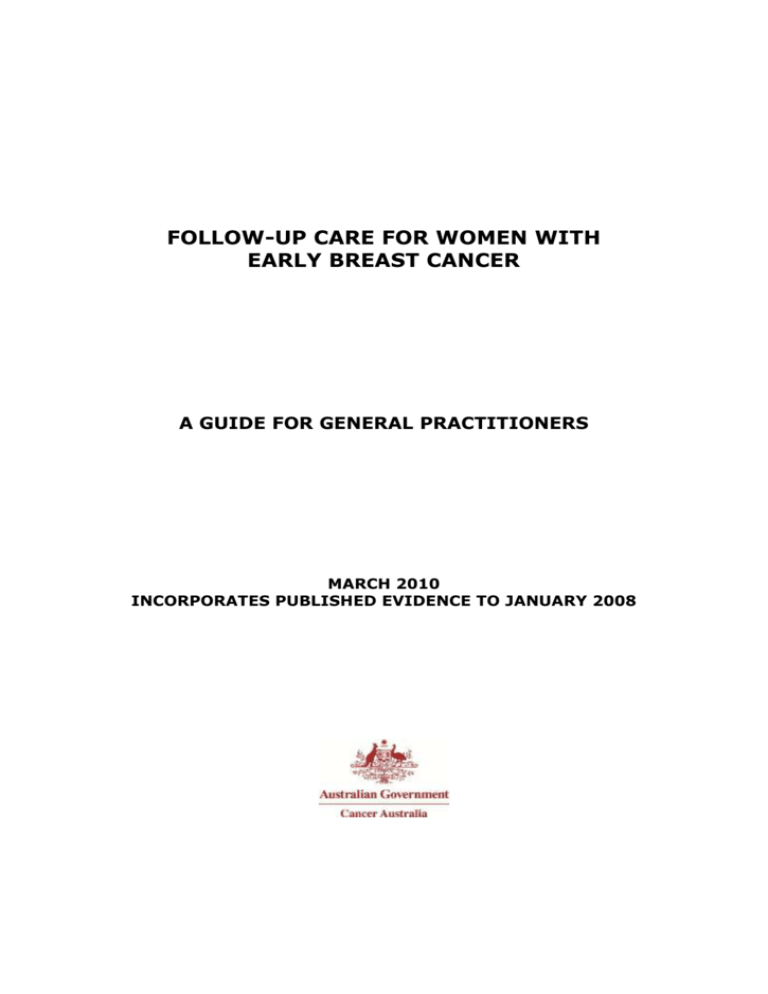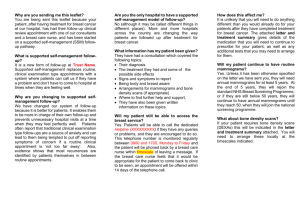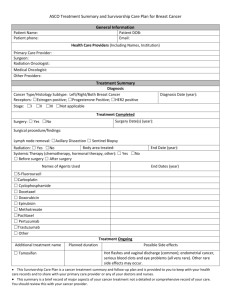Follow-up care for women with early breast cancer
advertisement

FOLLOW-UP CARE FOR WOMEN WITH EARLY BREAST CANCER A GUIDE FOR GENERAL PRACTITIONERS MARCH 2010 INCORPORATES PUBLISHED EVIDENCE TO JANUARY 2008 In March 2010, Cancer Australia published a clinical practice guideline about follow-up care for women who have been treated for early (operable) breast cancer. This summary is designed to assist general practitioners (GPs) in managing aspects of follow-up care and support for women following completion of active treatment for early breast cancer. Summary Women who have been treated for early breast cancer are at increased risk of local, regional or distant recurrence or development of a new primary breast cancer in the ipsilateral or contralateral breast Follow-up care is essential following completion of active treatment for early breast cancer and may be undertaken by specialists or GPs Psychosocial issues, anxiety and depression are common following diagnosis and treatment for breast cancer and an individual's needs may change over time Follow-up care includes managing the woman's expectations and empowering her to request or seek the care, support or information she needs. Purpose of follow-up care The purpose of follow-up care following treatment for early breast cancer includes: early detection of local, regional or distant recurrence screening for a new primary breast cancer (in the ipsilateral or contralateral breast) detection and management of psychosocial distress, anxiety or depression detection and management of treatment-related side effects reviewing and updating family history information observation of outcomes of therapy reviewing treatment, including new treatments that may be appropriate for the woman. Role of the GP A GP may undertake some or all aspects of follow-up care in collaboration with relevant specialists. Effective communication with the woman and members of her multidisciplinary team is important to ensure adherence to the agreed follow-up plan. Regardless of who undertakes follow-up care, GPs should be aware of potential sequelae of breast cancer treatment and remain alert for issues requiring further investigation. What does follow-up care involve? The standard follow-up schedule recommended by Cancer Australia is provided in Table 1. There is no evidence to indicate the optimal duration for which follow-up should be continued. This should be discussed between the woman and the health professionals involved in her care. Intensive follow-up involving chest X-rays, bone scans, CT, PET or MRI scans, and/or blood tests including full blood count, biochemistry or tumour markers does not confer any survival benefit or increase quality of life compared to a standard follow-up schedule (Level I evidence). Table 1: Recommended follow-up schedule following treatment for early breast cancer Method Years 1 and 2 Years 3 - 5 After 5 years History and clinical examination Every 3-6 months Every 6-12 months Every 12 months Mammography (and ultrasound if indicated)^ Every 12 months* Every 12 months Every 12 months Chest X-ray, bone scan, CT, PET, or MRI scans, full blood count, biochemistry and tumour markers Only if clinically Only if clinically Only if clinically indicated on suspicion indicated on suspicion indicated on suspicion of recurrence of recurrence of recurrence CT: computed tomography; PET: positron emission tomography; MRI: magnetic resonance imaging See Table 2; *First mammogram 12 months post diagnosis; Use of MRI may be considered in specific high risk groups. ^ What to check during follow-up appointments Listed below are key actions to be undertaken during follow-up appointments. Many factors influence an individual woman's requirements and her care may need to be tailored accordingly. Table 2: Actions to be taken during follow-up appointments Aspect of care What to check/do Other relevant Cancer Australia resources* History Check/confirm: Recommendations for follow-up of women with early breast cancer Clinical examination general health/new health problems new breast symptoms hormonal status risk factors/secondary prevention strategies (see 'other considerations' below) change in medications compliance issues. Examine: breast/chest wall (ipsilateral and contralateral) chest and abdomen regional lymph nodes arm on the treated side. Recommendations for follow-up of women with early breast cancer The management of secondary lymphoedema: a guide for health professionals Aspect of care What to check/do Imaging Arrange for a mammogram of the ipsilateral breast Recommendations for follow-up of (if breast conserving therapy) and contralateral women with early breast cancer breast Consider ultrasound in addition to mammography for younger women, women with dense breasts and those whose initial breast cancer could not be detected by mammography. Assess the woman's level of psychosocial distress and the impact of the disease and its treatment (including effects on sexuality, fertility and relationships) Provide appropriate support and referral Be aware that some women may find regular check-ups reassuring while others may associate them with increased anxiety. Check for early signs of secondary lymphedema If the woman is receiving ongoing treatment with hormonal therapies (eg tamoxifen or aromatase inhibitors), check for possible sequelae of treatment (menopausal symptoms or reduced bone mineral density) and refer for specialist review if necessary. Psychosocial care Treatment side effects Other considerations Actively promote secondary prevention strategies (including maintaining a healthy body weight, regular exercise and limiting alcohol intake). Other relevant Cancer Australia resources* Clinical practice guidelines for the psychosocial care of adults with cancer - a summary guide Psychosocial care referral checklist The management of secondary lymphoedema: a guide for health professionals Recommendations for aromatase inhibitors as adjuvant endocrine therapy for post-menopausal women with hormone receptor-positive early breast cancer — *Download or order online via Cancer Australia resources or call 1800 624 973. For full details of research evidence and supporting references, see Cancer Australia's Recommendations for follow-up of women with early breast cancer, March 2010. Cancer Australia does not accept any liability for any injury, loss or damage incurred by use of or reliance on the information. Cancer Australia develops material based on the best available evidence, however it cannot guarantee and assumes no legal liability or responsibility for the currency or completeness of the information. © Cancer Australia 2013





